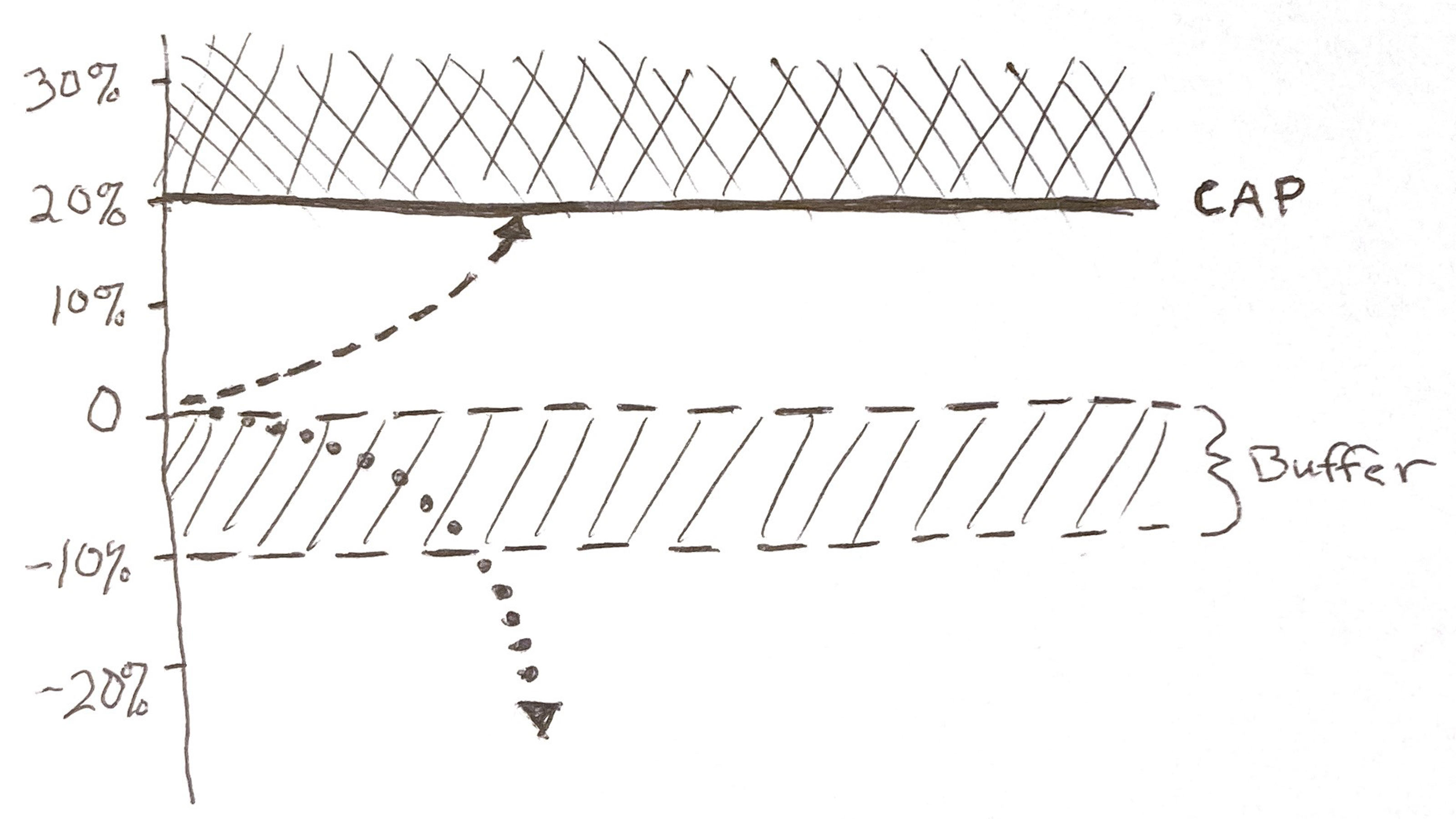Want Stock Market Gains but Hate Risk? Buffer Annuities May Be for You
Index-linked annuities are a new-ish way to help buffer your portfolio from market downdrafts while still allowing for some growth. Here are three things you must know before buying one.


Fed Chairman Jerome Powell's first action when the COVID-19 pandemic hit was to further loosen monetary policy by dropping interest rates to near zero. There's almost nowhere for rates to go but up … or sideways. Neither scenario is rosy for investors who need to take some risk off the table.
Because of the inverse relationship between interest rates and bond prices, a rising-rate environment promises to take the teeth out of fixed income investments for a while, at least. This is significant for recent retirees and those nearing retirement when they aim to navigate sequence-of-returns risk by decreasing their allocations to equities.
Without traditional fixed income safe havens, many investors have had to look elsewhere or possibly take on additional risk to meet their retirement goals. But for recent retirees, or those late in their careers, taking on additional risk without some measure of safety may not be an option.
From just $107.88 $24.99 for Kiplinger Personal Finance
Be a smarter, better informed investor.

Sign up for Kiplinger’s Free Newsletters
Profit and prosper with the best of expert advice on investing, taxes, retirement, personal finance and more - straight to your e-mail.
Profit and prosper with the best of expert advice - straight to your e-mail.
An Alternative: The Index-Linked Annuity
A relatively new solution in the marketplace, the index-linked annuity (ILA), allows investors to transfer some risk without sacrificing the possibility for some upside potential. Developed in the wake of the Great Recession, ILAs have piqued the interest of investors during the Coronacrash when markets cratered, then came roaring back in a five-week span.
When used as a portion of the overall portfolio, these protections may reduce the portfolio's overall risk by adding a buffer to smooth out the ride when markets get choppy.
With so much uncertainty, a flight to safety makes sense. Before pulling the trigger on an ILA, there are three important things to know:
- How you are paid.
- How the protections work.
- How the insurance company is paid.
How You are Paid
Depending on the type of protections you want, the return potential of the index-linked annuity may be dialed up or down. These options are offered in the form of performance “cap” rates.
To provide market-linked growth, the insurance company takes a portion of the funds you invest in the ILA to purchase call or put options. The cost of the options then determines the caps, or just how much of an index's performance you may be credited in a given one-year or three-year term — call it a ceiling of 10%, for instance.
Some points to keep in mind about how ILAs earn you money:
- There are many different index options to which your annuity can be linked. Instead of investing directly in underlying investment options like traditional variable annuities, you are credited interest via an index like the S&P 500 or Russell 2000. ILAs may offer many crediting choices, including indices built to track foreign markets, specialty indices or passive indices that track hedged ETFs, for instance.
- Dividends do not contribute to index returns. When the actual S&P 500 index delivers a 12% return, that generally means with dividends reinvested. Dividends can make up 1% to 2% of that return (source: ycharts), so the actual credit in an ILA may be more like 10% to 11%.
- Commonly, interest is credited to ILA owners on an anniversary via point-to-point crediting. The credit is then applied at the end of the cycle. And, generally speaking, the longer the cycle duration, the higher the cap rates and buffer protections. So a three-year point-to-point crediting method generally offers more growth potential — and safety — than a one-year point-to-point crediting method.
- Caps limit the amount of gains you may earn via a particular index. When you choose an index, you are subject to the rates offered by the issuing insurance company at that time. If a cap of 10% is placed on the S&P 500 index, then 10% is the most you may be credited for that period. If the S&P 500 returns 12% that year, you get 10%. If it returns 8%, you are credited with 8%. If it returns 50%, you still get 10%.
- In some cases, a flat return in an index will credit nothing to the ILA owner. However, some crediting options (precision rate strategies) promise a fixed rate of return if the indices are flat or positive for a given period.
- Gains grow tax-deferred for as long as you remain invested in the ILA.
How the Protections Work: Buffers and Floors
Index-linked annuities are also known as buffer annuities because of their primary protection feature: the buffer. Some ILAs also feature floor protections designed to limit losses as well, but again, transferring more risk to the issuing company may further limit upside.
- The buffer mechanism provides protections from losses up to a certain threshold — say 10%. If you have a buffer of 10%, this means that if the index to which your investment is linked loses 4%, you lose nothing. If it records a loss of 10% you lose nothing. You have been protected from losses for that period. However, say it falls 30%, then the insurance company absorbs the first 10% of that loss and you only lose 20%.
- Buffers may be offered in 10% increments, from 10% on up to 30%.
- Floors, if available, offer absolute protection against any losses above a certain amount, say 0% or -10%. The floor is essentially a stopper. Unlike the buffer, which protects against losses up through a certain percentage, the floor prevents any losses at all beyond a certain percentage. A 0% floor is a very conservative option, and it would protect against any losses at all. A -10% floor would protect against any losses beyond 10%. For instance, if you chose a -10% floor option and your crediting method lost 2% in a given period, you would suffer a 2% loss. If the index fell 9%, you would tally a 9% loss as well. But if the index lost 11% or more, your loss would not be more than 10%.
- To illustrate how caps and buffers work, let’s look at it graphically, with an index-linked annuity with a market participation cap of 20% and a loss buffer of 10%. In my napkin art below (Figure 1), you can see that even if the market rises above the 20% mark, the annuity’s performance hits a wall at 20%. Meanwhile, if the index suffers a loss, your investment won’t feel it until the loss surpasses 10%.

Figure 1: Example: 20% performance cap with 10% buffer. For illustrative purposes, only.
How Insurance Companies Make Money
ILA issuers traditionally invest the lion's share of ILA premiums in fixed income securities, like Treasuries, via their general account. The companies are then able take some profit from the yield generated in the general account. A very small amount of premium also goes into buying derivatives to protect the downside and create the index-linked performance caps. And while investors might think the insurance companies could profit through the caps on earnings, they don’t. Because investments aren’t actually made in the indices, but through using puts and calls, insurance companies don’t profit from the difference between the actual index return and the capped return.
ILAs may also charge a product fee, which varies from product to product. Many, in fact, charge no explicit fee. These product fees, if any, should be considerably lower for ILAs that don't pay commissions on their sale. Eliminating the commission lowers the internal cost, and the savings are passed on to you.
These zero-commission ILAs are often referred to as “advisory” solutions, because they were designed for financial advisers who charge a fee for their advice — as opposed to brokers who are paid commissions on the sale of investments.
ILAs recognized in the Barron's top 100 annuities for 2020 charge fees ranging from 0% to 1.25%. In fact, most ILAs on the Barron's list charge no explicit fee at all (source: Barron's). Generally speaking, the lower the fees, the better.
So how does that cost compare to, say, an index fund like an S&P 500 ETF? According to ETFdb.com, the most popular ETF by trading volume is the SPDR S&P 500 ETF (SPY) with an expense ratio of 0.095%. Mind you an ETF is an investment, and an ILA is an investment vehicle with insurance protections.
Other Potential Fees and Options
There's no additional cost for investing in the underlying index of an ILA (since you don't actually invest directly in the index). Of course, ILAs may offer other investment options (subaccounts) and/or optional enhanced features and protections that can increase their costs, so keep that in mind.
Some ILAs charge surrender penalties for a period of five or more years. Some do not. When speaking with your financial adviser about ILAs, be sure to ask about any surrender period, and what the penalties, if any, may be. Generally speaking, ILAs charging surrender penalties are able to offer better cap rates, and many grant 10% penalty-free annual withdrawals.
Both advisory ILAs and commission-based ILAs have their positives. Some people favor advisory ILAs for their low fees and flexibility, but there may be other factors to consider, such as the fees you may pay a financial adviser for their advice. Work with her or him to determine which may best suit your needs.
Forecast: Ongoing Volatility
As we await the development of a COVID-19 vaccine to safely return to our normal activities, market volatility promises to remain with us like a rude houseguest. Investors in the "fragile decade" — the last five working years through the first five years of retirement — may want to consider their options for safely bridging this period of uncertainty.
If an ILA is something you are considering, remember that while index performance on the upside may be limited, the buffers and floors can protect you from some or all losses. This is what you are paying for: a guarantee against some losses.
Staying invested in markets right now may be critical to long-term investing success, but being roiled by extreme volatility may be more than some portfolios can bear.
Profit and prosper with the best of Kiplinger's advice on investing, taxes, retirement, personal finance and much more. Delivered daily. Enter your email in the box and click Sign Me Up.

David Stone is founder and CEO of RetireOne™, the leading, independent platform for fee-based insurance solutions. Prior to RetireOne, David was chief legal counsel for all of Charles Schwab's insurance and risk management initiatives. He is a frequent speaker at industry conferences as well as an active participant on numerous committees dedicated to retirement income product solutions.
-
 Four Spa Retreats for Well-Heeled Retirees
Four Spa Retreats for Well-Heeled RetireesWe hand-picked these U.S. spa retreats for their serenity, amenities and dedication to the comfort of older travelers. All are located in the Continental U.S.
-
 Four Military Benefits That Have Helped My Family
Four Military Benefits That Have Helped My FamilyMilitary life can be challenging for servicemembers and their families, but they're offered some significant financial benefits to help cushion the blow.
-
 Why More Americans Are Redefining Retirement, Just Like I Did
Why More Americans Are Redefining Retirement, Just Like I DidRetirement readiness requires more than just money. You have a lot of decisions to make about what kind of life you want to live and how to make it happen.
-
 3 Major Changes Investors Must Prepare for in 2026
3 Major Changes Investors Must Prepare for in 2026A possible stock market bubble. Trump accounts. Tokenized stocks. These are just three developments investors need to be aware of in the coming months.
-
 A Compelling Case for Why Property Investing Reigns Supreme, From a Real Estate Investing Pro
A Compelling Case for Why Property Investing Reigns Supreme, From a Real Estate Investing ProInvestment data show real estate's superior risk-adjusted returns and unprecedented tax advantages through strategies like 1031 exchanges and opportunity zones.
-
 Stocks Close Out Strong Month With Solid Amazon Earnings: Stock Market Today
Stocks Close Out Strong Month With Solid Amazon Earnings: Stock Market TodayAmazon lifted its spending forecast as its artificial intelligence (AI) initiatives create "a massive opportunity."
-
 Are You Retired? Here's How to Drop the Guilt and Spend Your Nest Egg
Are You Retired? Here's How to Drop the Guilt and Spend Your Nest EggTransitioning from a lifetime of diligent saving to enjoying your wealth in retirement tends to be riddled with guilt, but it doesn't have to be that way.
-
 Government Shutdown Freezes National Flood Insurance Program: What Homeowners and Buyers Need to Know
Government Shutdown Freezes National Flood Insurance Program: What Homeowners and Buyers Need to KnowFEMA's National Flood Insurance Program is unavailable for new customers, increased coverage or renewals during the government shutdown.
-
 Separating the Pros From the Pretenders: This Is How to Tell if You Have a Great Adviser
Separating the Pros From the Pretenders: This Is How to Tell if You Have a Great AdviserDo you leave meetings with your financial adviser feeling as though you've been bulldozed into decisions or you're unsure of what you're paying for?
-
 Stocks Sink with Meta, Microsoft: Stock Market Today
Stocks Sink with Meta, Microsoft: Stock Market TodayAlphabet was a bright light among the Magnificent 7 stocks today after the Google parent's quarterly revenue topped $100 billion for the first time.